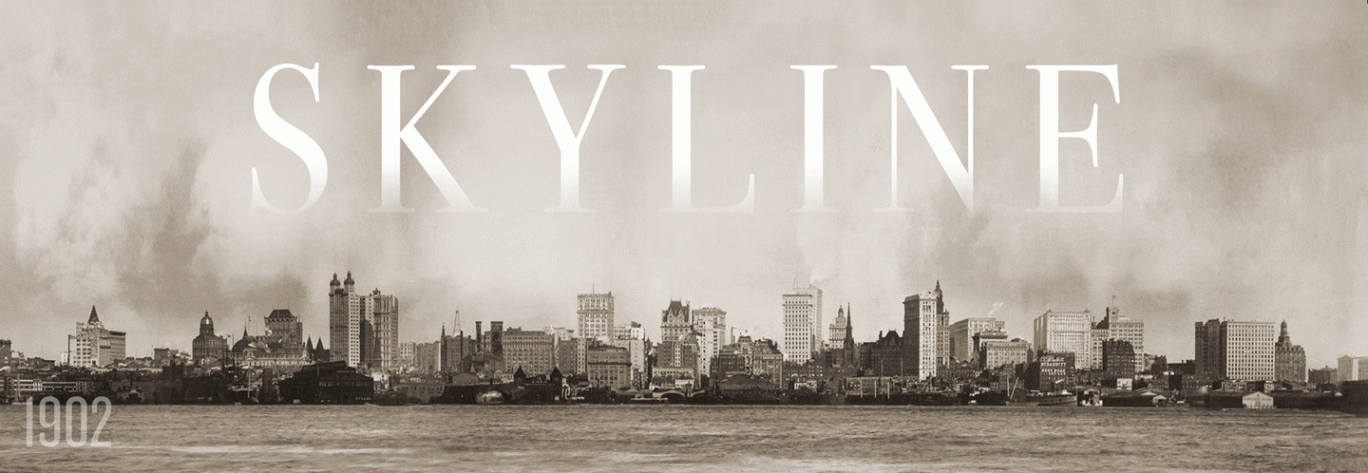Skyline
Now open at The Skyscraper Museum, a ground-breaking exhibition devoted to the invention and evolution of Manhattan’s skyline, past, present, and future. SKYLINE examines the emergence of the collective image of the skyline as the brand identity of New York, but also distinguishes five periods in which new buildings grow and take characteristic forms based on economic, technological, and regulatory factors. The exhibition traces the overarching story of Manhattan’s high-rise growth from small to tall, and taller. Cycles of boom and bust created the crowded clusters of Downtown and Midtown and today energize both geographies such as Hudson Yards and a new typology of super-slender residential towers, seen on “Billionaire’s Row” and in other areas with sweeping views of the skyline. Popular culture items such as early 20th-century postcards, souvenirs, magazines, and movies, as well as architectural models, photographs, and renderings trace the changes in both the conception of and physical form of the city over time.
The exhibition illustrates how Manhattan grew a skyline before writers found a word for it. The earliest skyscrapers, office buildings of ten stories, rose near City Hall Park in 1874. It was a full two decades later that a burst of towers of twenty stories, 300 feet or taller, truly transformed the city’s image. Located especially along the spine of Broadway from the Battery to Chambers Street, they composed a profile visible from both rivers. By 1900, this early period of the technological and stylistic invention had produced more than 100 office buildings of ten or more stories, including the 30-story Park Row Building (1899) near City Hall Park, which at 391 feet was the tallest skyscraper in the world.
In the second era of the skyline’s development, 1900 to 1916, the scale of buildings increased dramatically. From 1908 to 1916, lower Manhattan saw a series of record-breaking towers, including the Singer and Woolworth buildings, as well as the enormous, blocky Equitable and Municipal buildings. With the absence of any regulatory constraint on height or form, skyscrapers could cover every inch of their lot and, in theory, rise to unlimited height. In practice, they were limited by a “form follows finance” formula of the necessity of good light from large windows and by the goal of earning the highest percentage of return on the money invested. In this laissez-faire environment, the demand for the best locations created the tall, high-value corridor of Broadway and shaped the mound of buildings that crowded into the blocks around Wall and Broad streets and surrounding City Hall Park.
The third era of the skyline, from 1916 until the early 1960s, was defined by the characteristic setbacks and slender towers produced by the requirements of the city’s first zoning law. The regulations sculpted skyscrapers into ziggurats and pyramidal bases with slender tower shafts. Skyscrapers grew taller, rising Downtown to between 50 and 71 stories and crowded around Wall Street, representing the peaks of land values in that area.
The modernist skyline of glass towers—the fourth era of the skyline—began in the postwar years of the 1950s with rising dominance of the International Style and especially with the passage in 1961 of a new zoning law that changed the basic concept of how the mass and height of high-rises were regulated. The stepped pyramids and tall, thin towers of the third era were replaced by a new formula that set a maximum floor area (FAR) for the lot and that gave bonus interior floor area for plazas or public space around the building. Architects designed variations of pure rectangular volumes, enveloped by a glass curtain wall, air conditioned, and brightly illuminated by fluorescent light, so the night skyline glowed from within like glass lanterns
The year 2000 would have been the convenient date to mark a new phase of the skyline, but the events of September 11, 2001 made “before and after” a clear line. The destruction of the Twin Towers led many to claim that the era of tall buildings was over. Yet, in addition to the rebuilding at Ground Zero, only a decade after 9/11, supertall and super-slender towers were on the rise. In the fifth and current era, an even taller and more vertical skyline is appearing above that of the 20th century city. There are two characteristic types: office buildings or mixed-use structures, which have larger floor plates and greater girth; and residential towers which have slimmer proportions. At least twenty of these are supertall and super-slender condominium towers.
SKYLINE is the first “primer” to organize New York’s nearly 150 years of Manhattan’s high-rise development into significant periods of building shapes and urban form. Together with the parallel project on the Museum’s website, which includes all the graphics and texts in the exhibition, as well as the innovative interactive “sliders,” SKYLINE offers visitors a way to read urban history in the collective image and identity of the world’s first and greatest skyscraper city.
